The AMD Zen and Ryzen 7 Review: A Deep Dive on 1800X, 1700X and 1700
by Ian Cutress on March 2, 2017 9:00 AM ESTBenchmarking Performance: CPU Rendering Tests
Rendering tests are a long-time favorite of reviewers and benchmarkers, as the code used by rendering packages is usually highly optimized to squeeze every little bit of performance out. Sometimes rendering programs end up being heavily memory dependent as well - when you have that many threads flying about with a ton of data, having low latency memory can be key to everything. Here we take a few of the usual rendering packages under Windows 10, as well as a few new interesting benchmarks.
Corona 1.3
Corona is a standalone package designed to assist software like 3ds Max and Maya with photorealism via ray tracing. It's simple - shoot rays, get pixels. OK, it's more complicated than that, but the benchmark renders a fixed scene six times and offers results in terms of time and rays per second. The official benchmark tables list user submitted results in terms of time, however I feel rays per second is a better metric (in general, scores where higher is better seem to be easier to explain anyway). Corona likes to pile on the threads, so the results end up being very staggered based on thread count.
Blender 2.78
For a render that has been around for what seems like ages, Blender is still a highly popular tool. We managed to wrap up a standard workload into the February 5 nightly build of Blender and measure the time it takes to render the first frame of the scene. Being one of the bigger open source tools out there, it means both AMD and Intel work actively to help improve the codebase, for better or for worse on their own/each other's microarchitecture.
LuxMark
As a synthetic, LuxMark might come across as somewhat arbitrary as a renderer, given that it's mainly used to test GPUs, but it does offer both an OpenCL and a standard C++ mode. In this instance, aside from seeing the comparison in each coding mode for cores and IPC, we also get to see the difference in performance moving from a C++ based code-stack to an OpenCL one with a CPU as the main host.
POV-Ray 3.7
Another regular benchmark in most suites, POV-Ray is another ray-tracer but has been around for many years. It just so happens that during the run up to AMD's Ryzen launch, the code base started to get active again with developers making changes to the code and pushing out updates. Our version and benchmarking started just before that was happening, but given time we will see where the POV-Ray code ends up and adjust in due course.
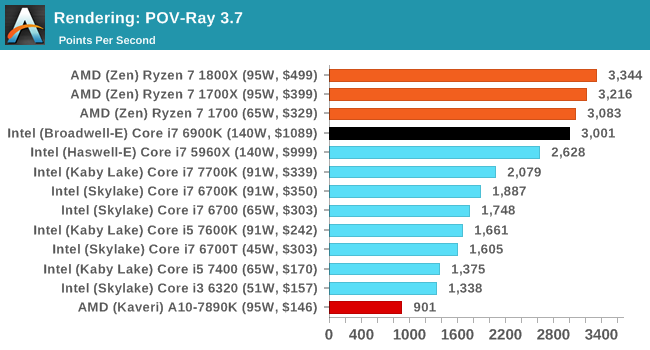
Cinebench R15
The latest version of CineBench has also become one of those 'used everywhere' benchmarks, particularly as an indicator of single thread performance. High IPC and high frequency gives performance in ST, whereas having good scaling and many cores is where the MT test wins out.
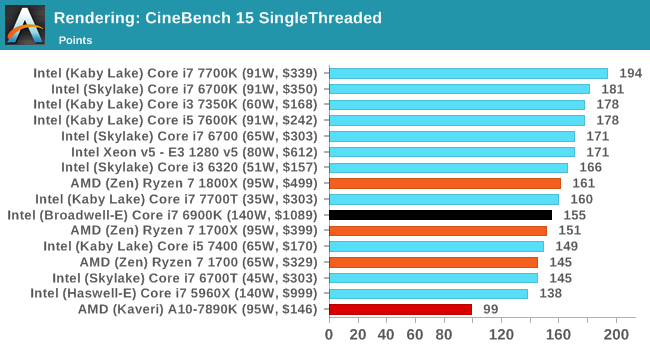
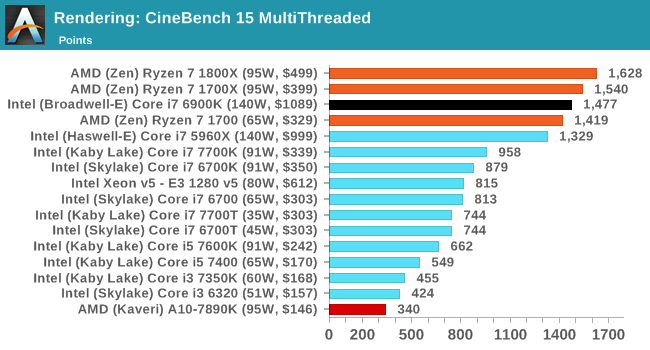


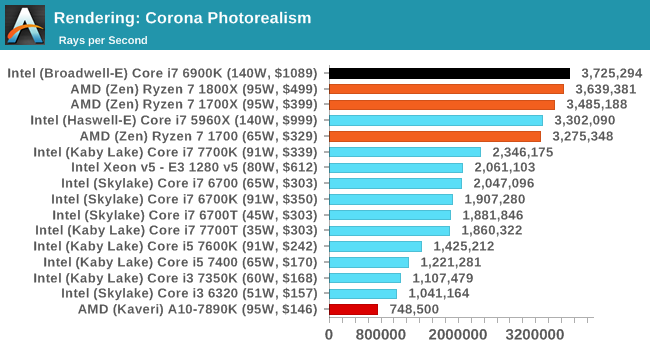
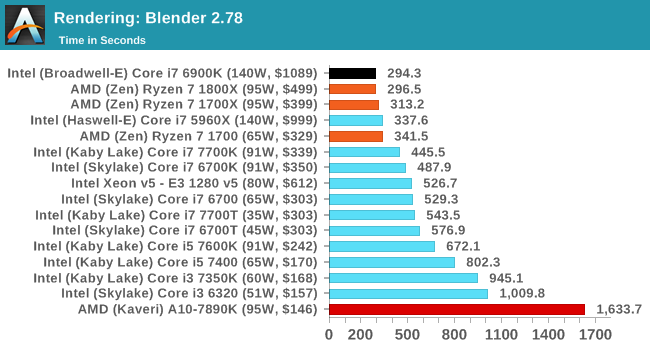

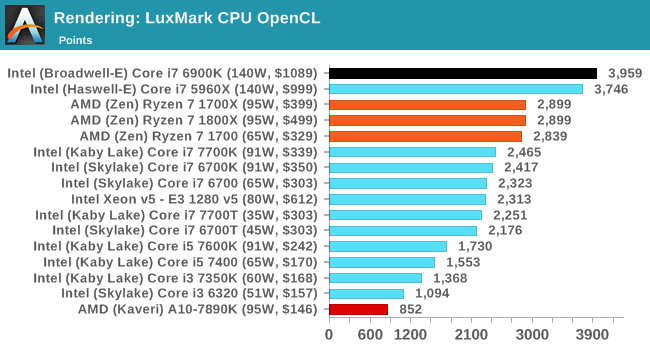








574 Comments
View All Comments
mapesdhs - Thursday, March 2, 2017 - link
It would be bizarre if they weren't clocked a lot higher, since there'll be a greater thermal limit per core, which is why the 4820K is such a fun CPU (high-TDP socket, 40 PCIe lanes, but only 4 cores so oc'ing isn't really limited by thermals compared to 6-core SB-E/IB-E) that can beat the 5820K in some cases (multi-GPU/compute).Meteor2 - Friday, March 3, 2017 - link
...Silverblue, look at the PDF opening test. What comes top? It's not an AMD chip.Cooe - Sunday, February 28, 2021 - link
Lol, because opening PDF's is where people need/will notice more performance? -_-CPU's have been able to open up PDF's fast enough to be irrelevant since around the turn of the century...
rarson - Thursday, March 2, 2017 - link
"AMD really isn't offering anything much for the mid range or regular desktop user either."So I'd HIGHLY recommend you wait 3 months, or overpay for Intel stuff. Because the lower-core Zen chips will no doubt provide the same performance-per-dollar that the high-end Ryzen chips are offering right now.
rarson - Thursday, March 2, 2017 - link
"their $499 CPU is often beaten by an i3."It's clear that you're looking at raw benchmark numbers and not real-world performance for what the chip is designed. If all you need is i3 performance, then why the hell are you looking at an 8-core processor that runs $329 or more?
Ratman6161 - Friday, March 3, 2017 - link
Its all academic to me. As I posted elsewhere, my i7-2600K is still offering me all the performance I need. So I'm just reading this out of curiosity. I also really, really want to like AMD CPU's because I still have a lot of nostalgia for the good old days of the Athlon 64 - when AMD was actually beating Intel in both performance and price. And sometimes I like to tinker around with the latest toys even if I don't particularly need it. I have a home lab with two VMWare ESXi systems built on FX-8320's because at the time they were the cheapest way to get to 8 threads - running a lot of VM's but with each VM doing light work.I also run an IT department so I'm always keeping tabs on what might be coming down the pike when I get ready to update desktops. But there is a sharp divide between what I buy for myself at home and what I buy for users at work. At work, most of our users actually would do fine with an i3. But I'm also keeping an eye out for what AMD has on offer in this range.
Notmyusualid - Tuesday, March 7, 2017 - link
@ Jimster480Sorry pal, but that is false, or inaccurate information.
ALL BUT the lowest model of CPUs in the 2011v3 platform are 40 PCIE lanes. Again, only the entry-level chip (6800K),has 28 lanes:
http://www.anandtech.com/show/10337/the-intel-broa...
But I do agree with you, that this is competing against the HEDT line.
Peace.
slickr - Thursday, March 2, 2017 - link
I'm sorry, but that sound just like Intel PR. I don't usually call people shills, but your reply seems to be straight out of Intel's PR book! First of all more and more games are taking advantage of more cores, you can easily see this especially with DX12 titles where if you have even 16 cores it will take advantage of.So having 8 cores for $330 to $500 is incredible value! We also see that the Ryzen chips are all competitive compared to the $1100 6900k which is where the comparison should be. Performance on 8 cores.
And as I've found out real world performance on 8 cores compared to 4 cores is like night and day. Have you tried running a demanding game, streaming in through OBS to Twitch, with the browser open to read Twitch chat and check other stuff in the process, while also having musicbee open and playing your songs and a separate program to read Twitch donations and text, etc...
This is where 4 core struggles a lot, while 8 core responsiveness is perfect. I can't use my PC if I decide to reduce a video size to a smaller one with a 4 core. Even 8 cores are fully taken advantage off, but through one core you can always do other stuff like watch movie or surf the internet without it struggling to process.
But even if games are your holy grail and what you base your opinion on, then Ryzen does really well. Its equal or slightly slower than the much much more optimized Intel processors. But you have to keep in mind a lot of the game code is optimized solely for Intel. That is what most gamers use, in fact over 80% is Intel based gamers, but developers will optimize for AMD now that they have a competitor on their hands.
We see this all the time, with game developers optimizing for RX 400 series a lot, even though Nvidia has the large majority of share in the market. So I expect to see anywhere from 10% to 25% more performance in games and programs that are also optimized for AMD hardware.
lmcd - Thursday, March 2, 2017 - link
How can you call someone a shill and post this without any self-awareness? Your real-world task is GPU-constrained anyway, since you should be using a GPU capable of both video encode and rendering simultaneously. If not, you can consider excellent features like Intel's Quick Sync, which works even with a primary GPU in use these days.Meteor2 - Friday, March 3, 2017 - link
Game code is optimised for x86.